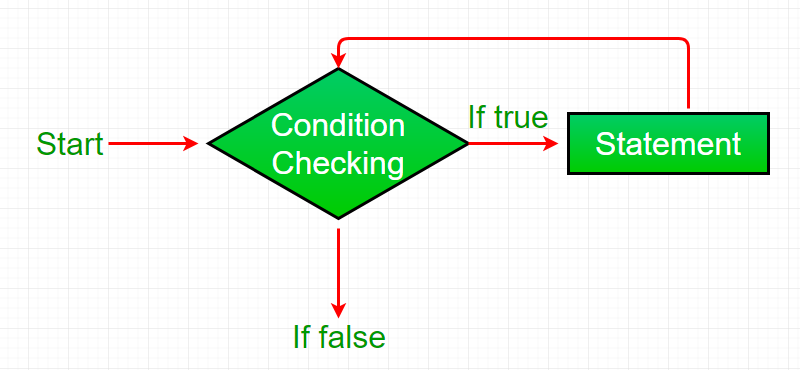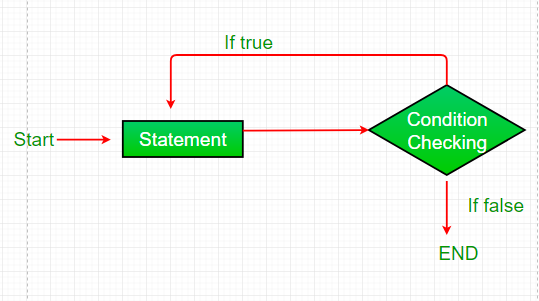How To Update Pane As Loop Is Processing Java
Loops in Java
Looping in programming languages is a characteristic which facilitates the execution of a set of instructions/functions repeatedly while some status evaluates to true.
Java provides iii ways for executing the loops. While all the ways provide like basic functionality, they differ in their syntax and condition checking time.
- while loop: A while loop is a control flow argument that allows code to be executed repeatedly based on a given Boolean condition. The while loop can exist thought of as a repeating if statement.
Syntax :while (boolean condition) { loop statements... }Flowchart:

- While loop starts with the checking of condition. If it evaluated to true, and so the loop body statements are executed otherwise offset argument following the loop is executed. For this reason it is also chosen Entry control loop
- Once the status is evaluated to true, the statements in the loop torso are executed. Ordinarily the statements contain an update value for the variable being processed for the next iteration.
- When the condition becomes simulated, the loop terminates which marks the end of its life bike.
formwhileLoopDemo{publicstaticvoidmain(String args[]){int10 =1;while(x <=4){Organisation.out.println("Value of x:"+ x);x++;}}}Output:
Value of x:1 Value of ten:two Value of ten:3 Value of ten:4
- for loop: for loop provides a curtailed way of writing the loop construction. Unlike a while loop, a for statement consumes the initialization, condition and increment/decrement in i line thereby providing a shorter, piece of cake to debug construction of looping.
Syntax:for (initialization condition; testing condition; increment/decrement) { statement(due south) }Flowchart:

- Initialization condition: Here, we initialize the variable in use. It marks the start of a for loop. An already alleged variable tin exist used or a variable tin can be declared, local to loop only.
- Testing Condition: Information technology is used for testing the exit condition for a loop. It must return a boolean value. It is also an Entry Control Loop as the condition is checked prior to the execution of the loop statements.
- Statement execution: Once the status is evaluated to truthful, the statements in the loop torso are executed.
- Increase/ Decrement: It is used for updating the variable for side by side iteration.
- Loop termination:When the status becomes false, the loop terminates marking the end of its life bike.
formforLoopDemo{publicstaticvoidmain(String args[]){for(intx =2; x <=4; x++)Arrangement.out.println("Value of x:"+ x);}}Output:
Value of x:two Value of x:iii Value of 10:4
Enhanced For loop
Java too includes another version of for loop introduced in Java 5. Enhanced for loop provides a simpler mode to iterate through the elements of a drove or array. It is inflexible and should be used merely when at that place is a need to iterate through the elements in a sequential manner without knowing the index of the currently processed element.
Too note that the object/variable is immutable when enhanced for loop is used i.e it ensures that the values in the array can not be modified, and then it can be said equally read-only loop where you tin can't update the values as reverse to other loops where values tin can be modified.
We recommend using this form of the for statement instead of the general grade whenever possible.(equally per JAVA physician.)
Syntax:for (T element:Collection obj/array) { statement(southward) }Lets take an example to demonstrate how enhanced for loop tin be used to simplify the work. Suppose there is an array of names and we desire to print all the names in that array. Allow's encounter the difference between these ii examples
Enhanced for loop simplifies the work equally follows-publicformenhancedforloop{publicstaticvoidmain(String args[]){String array[] = {"Ron","Harry","Hermoine"};for(String x:array){Arrangement.out.println(x);}}}Output:
Ron Harry Hermoine
- practise while: practice while loop is similar to while loop with but divergence that it checks for condition after executing the statements, and therefore is an example of Exit Control Loop.
Syntax:practise { statements.. } while (condition);Flowchart:

- practice while loop starts with the execution of the statement(s). There is no checking of any condition for the first time.
- After the execution of the statements, and update of the variable value, the status is checked for true or false value. If information technology is evaluated to true, next iteration of loop starts.
- When the status becomes simulated, the loop terminates which marks the end of its life wheel.
- It is important to note that the do-while loop will execute its statements atleast once before whatever condition is checked, and therefore is an example of exit command loop.
coursedowhileloopDemo{publicstaticvoidmain(Cord args[]){intx =21;do{Arrangement.out.println("Value of x:"+ x);10++;}while(x <xx);}}Output:
Value of 10: 21
Pitfalls of Loops
- Infinite loop: I of the most common mistakes while implementing whatever sort of looping is that that information technology may non ever exit, that is the loop runs for space time. This happens when the condition fails for some reason.
Examples:publicclassLooppitfallsDemo{publicstaticvoidmain(String[] args){for(inti =5; i !=0; i -=2){System.out.println(i);}intx =5;while(x ==5){Organisation.out.println("In the loop");}}} - Another pitfall is that you might be adding something into y'all collection object through loop and yous can run out of memory. If yous try and execute the below plan, after some fourth dimension, out of memory exception will be thrown.
importjava.util.ArrayList;publicclassInteger1{publicstaticvoidprimary(String[] args){ArrayList<Integer> ar =newArrayList<>();for(inti =0; i < Integer.MAX_VALUE; i++){ar.add(i);}}}Output:
Exception in thread "main" java.lang.OutOfMemoryError: Java heap space at java.util.Arrays.copyOf(Unknown Source) at java.util.Arrays.copyOf(Unknown Source) at java.util.ArrayList.grow(Unknown Source) at java.util.ArrayList.ensureCapacityInternal(Unknown Source) at coffee.util.ArrayList.add(Unknown Source) at article.Integer1.principal(Integer1.java:nine)
This article is contributed by Rishabh Mahrsee. If you like GeeksforGeeks and would similar to contribute, you can likewise write an article using write.geeksforgeeks.org or mail your article to review-team@geeksforgeeks.org. See your article actualization on the GeeksforGeeks main page and help other Geeks.
Please write comments if you observe anything incorrect, or you desire to share more information about the topic discussed above.
How To Update Pane As Loop Is Processing Java,
Source: https://www.geeksforgeeks.org/loops-in-java/
Posted by: giardinabeyea1951.blogspot.com


0 Response to "How To Update Pane As Loop Is Processing Java"
Post a Comment